Salvador Dali Biography
Born: May 11, 1904
Barcelona, Spain
Died: January 23, 1989
Figueras, Spain
Spanish painter and artist
The Spanish painter Salvador Dali was one of the best-known surrealist artists (artists who seek to express the contents of the unconscious mind). Blessed with an enormous talent for drawing, he painted his dreams and bizarre moods in a precise way.
Early life
Salvador Dali was born on May 11, 1904, near Barcelona, Spain. He was the son of Salvador and Felipa Dome (Domenech) Dali. His father was a notary (one who witnesses the signing of important documents). According to Dali's autobiography (the story of his own life), his childhood was filled with fits of anger against his parents and classmates and he received cruel treatment from them in response. He was an intelligent child, producing advanced drawings at an early age.
Dali attended the Colegio de los Hermanos Maristas and the Instituto in Figueras, Spain. By 1921 he convinced his father that he could make a living as an artist and was allowed to go to Madrid, Spain, to study painting. He was strongly influenced by the dreamlike works of the Italian painter Giorgio de Chirico (1888–1978). He also experimented with cubism (a type of art in which objects are viewed in terms of geometry—the science of points, lines, and surfaces). He was briefly imprisoned for political activities against the government and was finally thrown out of art school in 1925.
Association with surrealist movement
Dali's own style eventually began to show itself: he would draw, in an extremely precise manner, the strange subjects of his dream world. Each object, while carefully drawn, existed in strange contrast to other objects and was contained in a space that often appeared to tilt sharply upward. He applied bright colors

Reproduced by permission of
In the early 1930s many of the surrealists began to break away from the movement, feeling that direct political action had to come before any artistic revolutions. Dali put forth his "Paranoic-Critical method" as a way to avoid having to politically conquer the world. He felt that by using his own vision to color reality to his liking it would become unnecessary to actually change the world. The Paranoic-Critical method meant that Dali had trained himself to possess the power to look at one object and "see" another. This did not apply only to painting; it meant that Dali could take a myth that was interpreted a certain way and impose upon it his own personal ideas.
A key event in Dali's life during this time was meeting his wife, Gala, who was at that time married to another surrealist. She became his main influence, both in his personal life and in many of his paintings. Toward the end of the 1930s, Dali's exaggerated view of himself began to annoy others. André Breton (1896–1966), a French poet and critic who was a leading surrealist, angrily expelled Dali from the surrealist movement. Dali continued to be very successful in painting as well as in writing, stage design, and films, but his seriousness as an artist began to be questioned. He took a strong stand against abstract (unrealistic) art and began to paint Catholic subjects in the same tight style that had previously described his personal nightmares.
Later years
In 1974 Dali broke with English business manager Peter Moore and had the rights to his art sold out from under him by other business managers, leaving him with none of the profits. In 1980 a man named A. Reynolds Morse of Cleveland, Ohio, set up an organization called Friends to Save Dali. Dali was said to have been cheated out of much of his wealth, and the goal of the foundation was to put him back on solid financial (relating to money) ground.
In 1983 Dali exhibited many of his works at the Museum of Contemporary Art in Madrid. This show made him hugely famous in Spain and brought him further into favor with the Spanish royal family and major collectors around the world. After 1984 Dali was confined to a wheelchair after suffering injuries in a house fire.
Dali died on January 23, 1989, in Figueras, Spain. He was remembered as the subject of much controversy (dispute), although in his last years, the controversy had more to do with his associates and their dealings than with Dali himself.
For More Information
Carter, David A. Salvador Dali. New York: Chelsea House, 1995.
Dalí, Salvador. Diary of a Genius. New York: Doubleday, 1965.
Dali, Salvador. The Secret Life of Salvador Dali. New York: Dial Press, 1942. Reprint, New York: Dover, 1993.
Descharnes, Robert. The World of Salvador Dali. New York: Harper & Row, 1962.
Etherington-Smith, Meredith. The Persistence of Memory: A Biography of Dali. New York: Random House, 1992.